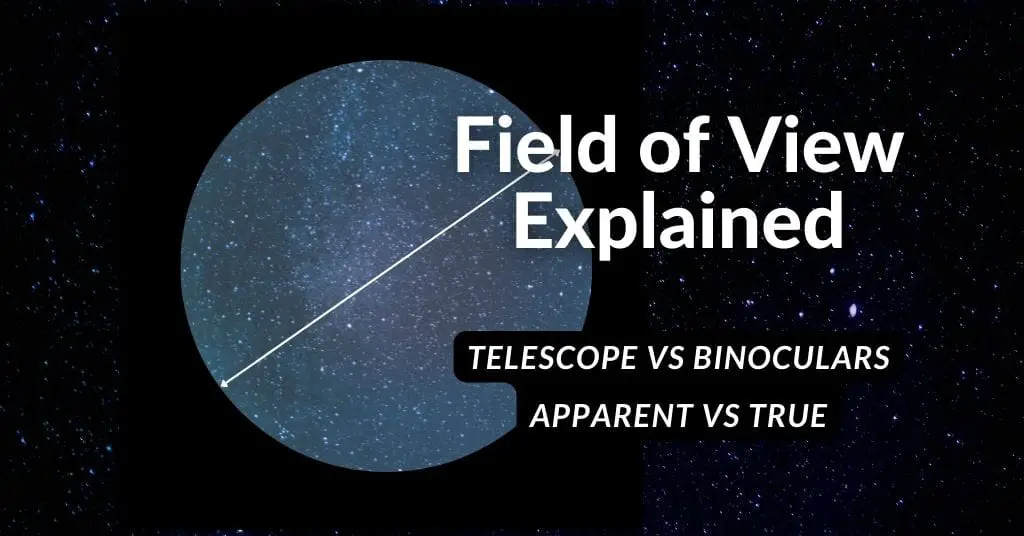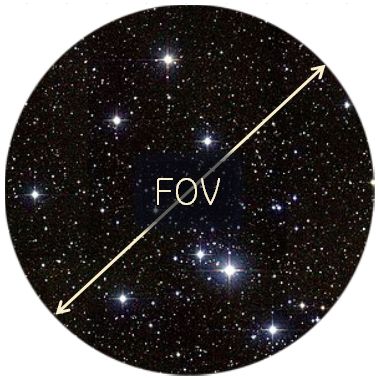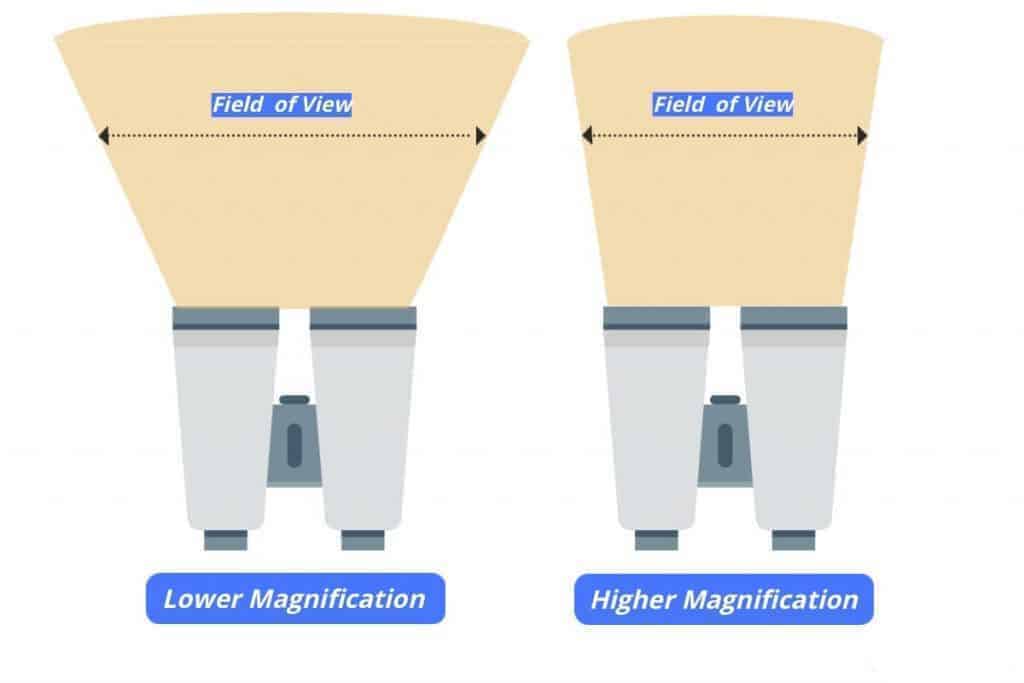The term field of view confuses a lot of people new to the hobby of astronomy. Here’s what to know about the field of view in optical instruments to help you demystify this term and get better satisfaction out of using your gear.

Define field of view
“Field of view is the extent or the range of your visual area.” ~ Optics Den
In astronomy, the field of view “is the angular width of the patch of sky you can see through your optical instrument” (Mosley, 2003). In binoculars the units are usually expressed as degrees or feet @ 1000 yds and in telescopes, degrees or arcminutes.
You’ll see field of view described as both ‘apparent’ (AFOV) and ‘true’ (TFOV).
Apparent field of view
Apparent field of view (AFOV) is a fixed property of an eyepiece. It is the angular diameter of the circular view created by the eyepiece’s field stop. You’ll see this measure listed in telescope eyepiece specifications.
In a nutshell, the AFoV is a fixed diameter that’s a property of the eyepiece, whereas the TFoV depends on magnification in association with the AFoV of the instrument.
True field of view
The true field of view (TFOV) is what you see of the sky when looking through your optical set up, e.g. a pair of binoculars, the eyepiece of a telescope, or your naked eyes. It depends on the power and structure of your viewing mechanism.
Here’s what to expect in numbers…
Field of view numbers
True field of view metrics as a guide for different mechanisms:
- Naked eye — 100º
- Average pair of binoculars — 5º– 8º
Field of view telescope:
- Average spotting scope — 2°–1.4°
- Average low power telescope — 0.5º or 30 arcminutes (‘)
- Average high power telescope — 0.166º or 10′
Telescope field of view
The telescope’s field of view is the diameter of the circle of space viewed through this optical instrument (see diagram).
It’s determined by the telescope’s power and the AFOV of the eyepiece. It is typically expressed as arcminutes.

How to calculate the Field of view of a telescope
Method 1:
- TFoV = AFoV of eyepiece ÷ magnification (telescope focal length ÷ eyepiece focal length). Example:
- TFL÷EFL… say 900 mm ÷ 20 mm = magnification, 45x.
- AFoV of 100º ÷ magnification of 45 = TFoV of ~2.22° (or 133.3 arcminutes).
Method 2:
Based on the field stop dimensions…
- TFoV = eyepiece field stop diameter ÷ telescope’s focal length x 57.3
Few brands list this field stop dimension, apart from TeleVue.
Why care about AFoV of eyepieces?
Here’s why AFoV matters: A wider AFoV will give you more sky in your view at a particular magnification. Let’s look at variations of these parameters with three different AFoV…
| AFOV | Magnification | TFOV |
| 50º | 35x | 1.4325º |
| 50º | 49x | 1.0204º |
| 50º | 57x | 0.8772º |
| 70º | 35x | 2.0000º |
| 70º | 49x | 1.4325º |
| 70º | 57x | 1.2281º |
| 82º | 35x | 2.3429º |
| 82º | 49x | 1.6734º |
| 82º | 57x | 1.4325º |
A 50º (AFoV) Plossl at 35x (magnification), a 70º superwide at 49x, and an 82º ultrawide at 57x gives the same TFoV of 1.4325º (Method 1 — AFoV÷magnification).
Also, lower magnifications give wider views for each eyepiece.
Putting it another way…
Consider a 13 mm and 21 mm (as in TeleVue Ethos eyepieces).

TeleVue 21mm Ethos
available at Amazon (affiliate link)

TeleVue 13mm Ethos
available at Amazon (affiliate link)
The 13 mm gives a view that’s about double the magnification of the 21 mm — The object looks about twice as big through the 13 as opposed to the 21 mm.
Because both have a 100° AFoV, the 13 mm will have a smaller TFoV as you are only fitting in half of the image you get with the 21 mm.
Where AFoV separates the eyepieces…
what are the advantages of knowing the diameter of the field of view at a given magnification
If you have two eyepieces with the same magnification but different AFoV, you’d choose the eyepiece with the wider apparent field of view if you want to see more of the sky in your view.
For example, consider a telescope with focal length of 900 mm with these:
- 8 mm Plossl with 50º (AFoV) and a field stop of 6.5 mm
- 8 mm Ethos with 100º (AFOV) and a field stop of 13.9 mm
Compare AFoV of eyepieces
TFoV 1
8 mm Plossl 50º AFoV
eyepiece field stop diameter (6.5) ÷ telescope’s focal length (900) x 57.3
= 0.41º
TFoV 2
8 mm Ethos 100º AFoV
eyepiece field stop diameter (13.9) ÷ telescope’s focal length (900) x 57.3
= 0.88º
You’ll get a much wider view of the sky with the latter unit, about twice as much in fact.
It’s much the same with binoculars…
Field of view binoculars
In binoculars, the field of view is expressed as degrees or a linear measure of width (e.g., feet @ 1000 yds). To convert angle to linear feet FOV, multiply it by 52.5 (based on at 1000 yards, one degree is 52.5 feet).
Field of view (FOV) expresses the circular view through binoculars.
Field of view is a product of the diameter of the objective (front) lens in relation to magnification, plus other design and structure factors.
Joe Arterburn, 2019, Bushnell
With binoculars you can enjoy a wider field of view, say 5–8º, compared to that of a telescope (< 1º). This FoV corresponds to four fingers at arms length held up to the sky (see my article on hand measures).

Basically, the higher the power, the narrower the field of view for the same diameter. This is something to weigh up when choosing astronomy binoculars.
If a binocular says it has FOV of 341 feet at 1000 yards, it means you can see 341 feet of a scene from left to right when looking at 1000 yards.
Target Tamers
It’s important to understand these features as it helps in choosing the right eyepiece and getting the most satisfaction out of using your telescope to observe planets or other objects or with using binoculars for astronomy.
References
- Mosley, John. Starry Night Companion. Space Holding Corp. Canada.
